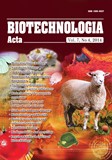ααISSN 2410-7751 (Print)
ISSN 2410-776X (Online)

"Biotechnologia Acta" v. 7, no 4, 2014
https://doi.org/10.15407/biotech7.04.043
Р. 43-48, Bibliography 22, Ukrainian.
Universal Decimal classification: 577.15.:577.152.3
Penicillium sp. — PRODUCER OF EXTRACELLULAR α-L-RHAMNOSIDASE
Gudzenko E. V.. Varbanets L. D., Kurchenko I. M., Naconechnaya L. T.
Institute of Microbiology and Virology of the National Academy of Sciences of Ukraine, Kyiv
The purpose of this work was to investigate ?-L-rhamnosidase that hydrolytically cleaves the terminal unreduced α-1,2-, α-1,4- and α-1,6-linked rhamnose residues in both synthetic and natural glycosides, oligo-, and polysaccharides, various glycoconjugates: flavonoid derivatives such es rutin, neohesperidin, hesperidin, naringin, quercitrin, saponins, terpene glycosides. These properties of the enzyme could be used for the needs of food industry, pharmaceutical and chemical industry: to improve the quality of beverages (reduction of bitterness, flavor enhancing wines), for production of food additives, medicine preparations and rhamnose.
As a result of screening conducted among 9 strains of micromycetes, ability to synthesize ?–Lrhamnosidase was revealed only in Penicillium sp. 2918. Complex enzyme preparation was obtained from culture supernatant of this micromycete by fractionation with ammonium sulfate (90% saturation) and its physico-chemical properties such as pH- and thermooptimum, pH- and thermal stability and substrate specificity were studied as well. It is shown that enzyme has pH optimum is about 6.0 and thermooptimum is about 60 оC. Preparation of Penicillium sp. 2918 with α-L-rhamnosidase reveals β-D-glucosidase, β-D-galactosidase and β-D-glucosaminidase
activity.
Key words: Penicillium sp. 2918, ?-L-rhamno sidase, micromycetes, physical and chemical properties, substrate specificity.
© Palladin Institute of Biochemistry of the National Academy of Sciences of Ukraine, 2014
References
1. Gudzenko O. V., Varbanets L. D. Mіkrobial ?Lrhamnosidases: producers, properties, practical use. Bіotekhnolohіia. 2012, 5(6), 9–26. (In Ukrainian).
2. Yadav V., Yadav P. K., Yadav S., Yadav K. D. S. ?LRhamnosidase: A review. Process Biochemistry. 2010, 45(8), 1226–1235.
3. Romero C., Manjon A., Bastida J. A method for assaying rhamnosidase activity of naringinase. Anal. Biochem. 1985, 149(2), 566–571.
4. Davis D. W. Determination of flavonones in citrus juice. Anal. Biochem. 1947, 19(1), 46–48.
5. Lowry O. H., Rosenbrough N. J., Farr A. L., Randall R. J. Protein measurement with the Folin phenol reagent. J. Biol. Chem. 1951, 193(1), 265–275.
6. Lakin G. F. Biometrics. Moscow: Vysshaya shkola. 1990, 325 p. (In Russian).
7. Yadav S., Yadav R. S. S., Yadav K. D. S. ?LRhamnosidae from Aspergillus awamori MTCC2879 and its role in debittering of orange juice. Int. J. Food Sci. Technol. 2013, 48(5), 927–923.
https://doi.org/.1111/ijfs.12043
8. Yadav V., Yadav K. D. S. New fungal for ?Lrhamnosidase an important enzyme used in the synthesis of drugs and drug precursors. Appl. Biochem. Microbiol. 2010, 48(3), 295–301.
https://doi.org/10.1134/S0003683812030155
9. Jang I. S., Kim D. H. Purification and characterization of alphaLrhamnosidase from Bacteroides JY6, a human intestinal bacterium. Biol. Pharmaceut. Bul. 1996, 19(1), 1546–1549.
https://doi.org//10.1248/bpb.19.1546
10. Park S., Kim J., Kim D. Purification and characterization of quercitrinhydrolyzing alphaLrhamnosidase from Fusobacterium K60, a human intestinal bacterium. J. Microbiol. Biotechnol. 2005, 15(3), 519–524.
11. Hashimoto W., Murata K. ?LRhamnosidase of Sphingomonas sp. R1 producing an unusual exopolysaccharide of sphingan. Biosc. Biotechnol. Biochem. 1998, 62(6), 1068–1074.
https://doi.org/10.1271/bbb.62.1068
12. Rodr?guez M. E., Lopes C. A., Broock M. Screening and typing of Patagonian wine yeasts for glycosidase activities. J. Appl. Microbiol. 2004, 96(1), 84–95.
https://doi.org/10.1046/j.1365-2672.2003.02032.x
13. Yanai T., Sato M. Purification and Characterization of aLRhamnosidase from Pichia angusta X349. Biosci. Biotechnol. Biochem. 2000, 64(10), 2179–2185.
https://doi.org//10.1271/bbb.64.2179
14. Varbanets L. D., Borzova N. V. Glycosydases of microorganisms and methods of their investigations. Kyiv: Naukova dumka. 2010. 437 p. (In Ukrainian).
15. Gerstorfenova D., Fliedrova B., Halada P., Marhola P., K?ena V., Weignerov? La. Recombinant ?Lrhamnosidase from Aspergillus terreus in selective trimming of rutin. Proc. Biochem. 2012, 47(5), 828–835.
https://doi.org/10.1016/j.procbio.2012.02.014
16. Manzanares P., Orejas M., Gil J. V. Construction of a Genetically Modified Wine Yasts Strain Expressing the Aspergillus aculeatus rhaA Gene, Encoding and ?LRhamnosidase of Enological Interest. Appl. Envir. Microbiol. 2003, 69(12), 7558–7562.
17. TamayoRamos J., Flipphi M., Pardo E. LRhamnose induction of Aspergillus nidulans aLrhamnosidase genes is glucose repressed via a CreAindependent mechanism acting at the level of inducer uptake. Microb. Cell Fact. 2012, V. 11, P. 11–26.
18. Orrillo A. G., Ledesma P., Delgado O. D. Coldactive aLrhamnosidase from psychrotolerant bacteria isolated from a subAntarctic ecosysteme. Enz. Microb. Technol. 2007, 40(2), 236–241.
19. Koseki T., Mese Y., Nishibori N. Characterization of an ?Lrhamnosidase from Aspergillus kawachii and its gene. Appl. Microbiol. Biotechnol. 2008, 80(6), 1007–1013.
20. Gudzenko E. V., Varbanets L. D. Purification and physicochemical properties of Eupenicillium erubescens ?Lrhamnosidase. Mіkrobіol. zh. 2012, 74(2), 14–21. (In Russian).
21. Monti D., Pisvejcova A., Kren V. Generation of an ?Lrhamnosidase library and its application for the selective derhamnosylation of natural products. Biotechnol. Bioengin. 2004, 87(6), 763–771.
https://doi.org/10.1002/bit.20187
22. Varbanets L. D., Gudzenko E. V. ?LRhamnosidase microorganisms. Abstracts of the I AllRussian Conference «Fundamental glycobiology», Kazan, 20–24 June 2012. (In Russian).

